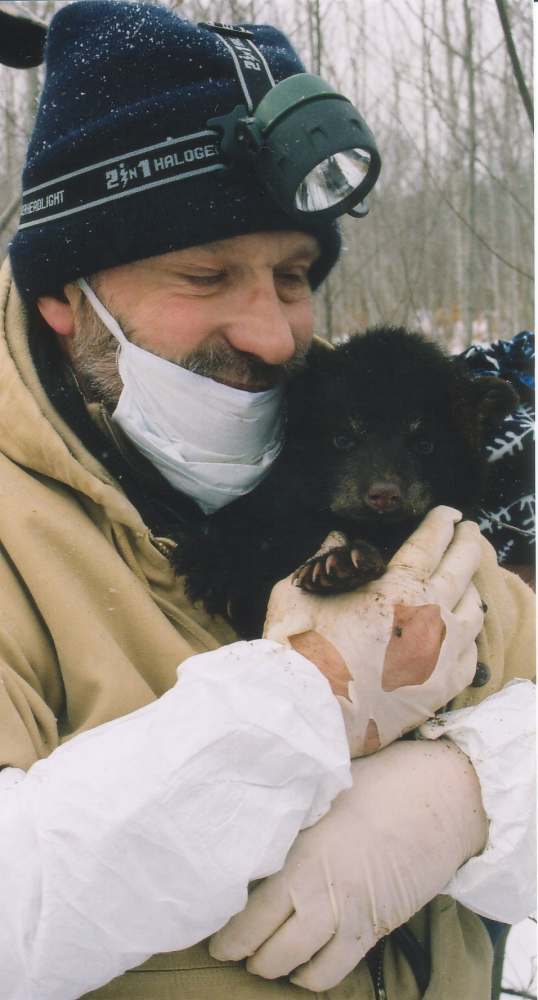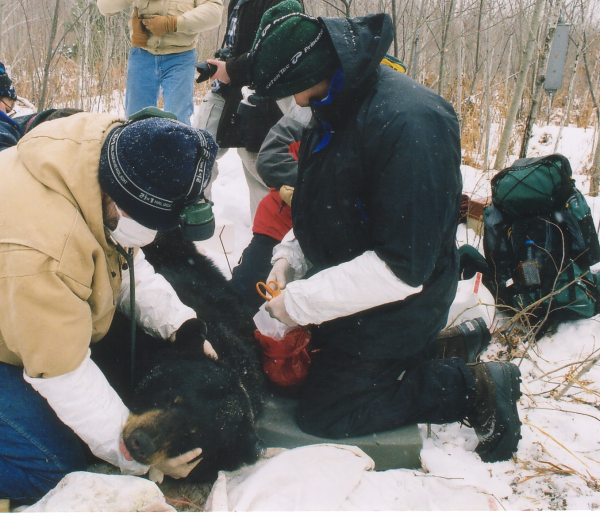“MOTHER KNOWS BEST… Mother Bear, Mother Nature team for medical miracle”
By Dick Ellis
 Almost a mile off the nearest logging road west of Neillsville, DNR Bear Biologist Mike Gappa finishes the trek through the Clark County snow and leads two researchers to the sow’s shallow den burrowed out months before among a stand of immature aspen. Pressed against the entrance Mother Bear is protecting her precious secrets, four rambunctious cubs, from the real world outside.
Almost a mile off the nearest logging road west of Neillsville, DNR Bear Biologist Mike Gappa finishes the trek through the Clark County snow and leads two researchers to the sow’s shallow den burrowed out months before among a stand of immature aspen. Pressed against the entrance Mother Bear is protecting her precious secrets, four rambunctious cubs, from the real world outside.
Deep within the den, Mother Nature is protecting her secrets too. Although the sow has remained relatively motionless since taking to the den five months before, she apparently has suffered little muscle atrophy or bone mass loss. And certainly, insignificant losses to negatively affect her health or ability to function. If compelled to do so, in fact, the sow could bolt from den instantaneously and be on the move as if she had never been in this hibernation-like state at all.
Despite her extended slumber, the sow has maintained her own excellent health and provided nourishment for her newborns that are nursing constantly on extraordinarily rich milk consisting of 30 percent fat and 10 percent protein. These cubs at seven weeks of age and seven pounds are already at weights expected in youngsters a month older. Somehow, she accomplishes this by bypassing the kidney, and without eating, drinking, urinating, or defecating for four or five months. .
With an extensive history studying osteology and anatomy, naturalist Valentine Vogel, and Professor Danny Riley, Ph.D. of the Department of Cell Biology, Neurobiology and Anatomy at the Medical College of Wisconsin,are hoping to coax those secrets from Mother Nature. And translate the knowledge into astronomical benefits for both the medical field and future space flight.
In stark contrast to wintering bears, persons bedridden for relatively short periods experience great difficulty when using those muscles again. According to Dr. Riley, who for twenty-five years has worked extensively with muscle atrophy in astronauts with the NASA space program, the breakdown of human muscle in the weightlessness of space and the deterioration of muscle in hospital patients correlates closely.
“It appears that time in space lowers the tolerance of muscles,” he said. “Astronauts experience Delayed Onset Muscle Soreness, like when you exercise and are sore the next day. The fibers also break and the muscles tear more easily. And if you came here to Froedtert Hospital and asked someone who has been in bed for two weeks to walk down the hall, he couldn’t do it very well.”
 Medical insight into muscle atrophy and bone mass loss, though, only touch on the “treasure trove “of biomedical advances possible through studying just how bears survive and thrive, in nature. Cardiovascular disease, diabetes, osteoporosis, organ transplants, anorexia, obesity and cholesterol-related issues and other monumental medical problems may all reap the benefits.
Medical insight into muscle atrophy and bone mass loss, though, only touch on the “treasure trove “of biomedical advances possible through studying just how bears survive and thrive, in nature. Cardiovascular disease, diabetes, osteoporosis, organ transplants, anorexia, obesity and cholesterol-related issues and other monumental medical problems may all reap the benefits.
The potential benefits of the bear to human medical research in preventing disease is immense, said Vogel, who sought the expertise of Riley and the resources of the Medical College to pursue his theories regarding health and hibernation. Theories Vogel developed over decades of study in osteology and anatomy during commissioned work with the Milwaukee County Zoo, Milwaukee Public Museum, the San Diego Zoo and Living Desert Zoo in Palm Springs, California.
“I feel certain that the causes of the physical and behavioral changes in black bears is related to the amount of fat that surrounds the physical body, muscle fiber and bone structure,” he said. “Answers and truths into the behaviors of bears will be found in the closer study and research of white and brown fat cells.”
Large accumulations of brown adipose tissue or fat are found in wintering bears, he said. Much less or a complete absence of this fat is found in spring. Of the two types (white and brown cell) of “sub cutis” fat, brown cell fat is essential to rapid muscle and bone development and is prevalent in many mammals during fetal or neonatal periods.
“Every infant born, human or animal has brown fat, but it’s gone as the animal develops,” he said. “A wildebeest in Africa is running with the herd 15 minutes after birth. Why does it have brown fat? Brown fat protects muscle. Brown fat holds the biggest key in our work with the black bears.”
Vogel believes when the bear has built up enough fat to sustain it and in the case of sow, its cubs, through winter, and can no longer find the nutrients to increase the fats, proteins, and enzymes essential to survival, it enters it’s hibernation-like state. The building of fat, and hibernation correlates with the changing seasons and the absence of natural foods in the wild including grasses, berries, nuts, and the occasional protein and meat values found in insects or fawns.
The bear, Vogel theorizes, maintains its health through winter without drinking, eating, urinating, or defecating, due to a chemical change in the brown cell sub fat around the organs and close to the muscle; a change that in part transforms the saturated fat, or solids, into unsaturated or oily fats with protective characteristics vital to survival.
This change may release proteins and enzymes or other substances that stimulates the muscle fiber and bone, enters the heart and vascular system, and initiates a chain reaction that affects other tissues and organs including the brain and nervous system, lymphatic system, digestive system, urinary system, reproductive organs and skeletal structure
“The fats also nourish these tissues and organs to prevent muscle and bone loss, especially in weight-bearing muscles.” Vogel said. “Strength and agility is important when the fat supply is depleted and the bear recovers from its hibernating state.”
On March 4th, Biologist Gappa approaches the den and uses a syringe mounted on a jab-stick to immobilize the sow. He pulls the four bewildered cubs from their home for weighing and safe-keeping in the warm jackets of observers. The sow is pulled from the den. In the cold and wide-open spaces, Riley and Vogel, with assistance from Graduate Students Brian Curry and Dave Baewer methodically go through the familiar process of taking fat and muscle tissues and blood samples from Mama Bear.
To keep lab results unbiased, samples are taken and compared from the same bears in summer months and again during hibernation. To date, eight bears have been sampled during the ongoing research that began in 2001.
Samples secured, the sow is returned to the den, no worse for wear. No longer her secret from the outside world, four cubs are snuggled in again to nurse and grow on Mama Miracle’s wonderful body.
Riley and Vogel turn and begin the long hike back to the truck. Next stop, the Medical College of Wisconsin. Hopefully, the biggest secret hidden in the bear’s den is one step closer to being told.
NEXT WEEK: THE RESEARCH









